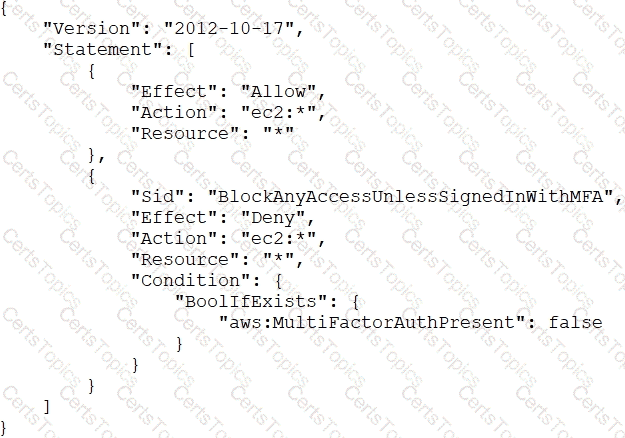A security engineer needs to implement a write-once-read-many (WORM) model for data that a company will store in Amazon S3 buckets. The company uses the S3 Standard storage class for all of its S3 buckets. The security engineer must ensure that objects cannot be overwritten or deleted by any user, including the AWS account root user.
An AWS account administrator created an IAM group and applied the following managed policy to require that each individual user authenticate using multi-factor authentication:

After implementing the policy, the administrator receives reports that users are unable to perform Amazon EC2 commands using the AWS CLI.
What should the administrator do to resolve this problem while still enforcing multi-factor authentication?
A company has enabled Amazon GuardDuty in all AWS Regions as part of its security monitoring strategy. In one of its VPCs, the company hosts an Amazon EC2 instance that works as an FTP server. A high number of clients from multiple locations contact the FTP server. GuardDuty identifies this activity as a bruteforce attack because of the high number of connections that happen every hour.
The company has flagged the finding as a false positive, but GuardDuty continues to raise the issue. A security engineer must improve the signal-to-noise ratio without compromising the companys visibility of potential anomalous behavior.
Which solution will meet these requirements?
An IAM user receives an Access Denied message when the user attempts to access objects in an Amazon S3 bucket. The user and the S3 bucket are in the same AWS account. The S3 bucket is configured to use server-side encryption with AWS KMS keys (SSE-KMS) to encrypt all of its objects at rest by using a customer managed key from the same AWS account. The S3 bucket has no bucket policy defined. The IAM user has been granted permissions through an IAM policy that allows the kms:Decrypt permission to the customer managed key. The IAM policy also allows the s3:List* and s3:Get* permissions for the S3 bucket and its objects.
Which of the following is a possible reason that the IAM user cannot access the objects in the S3 bucket?